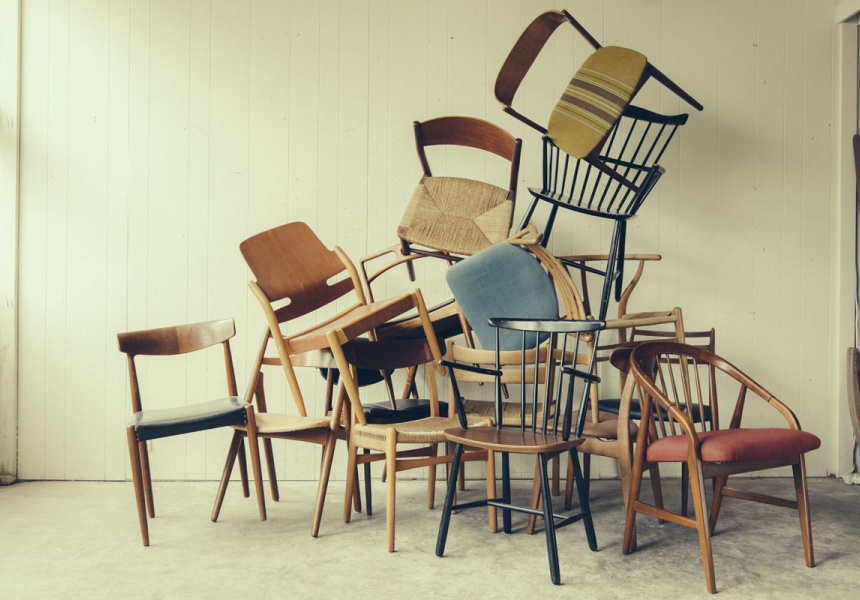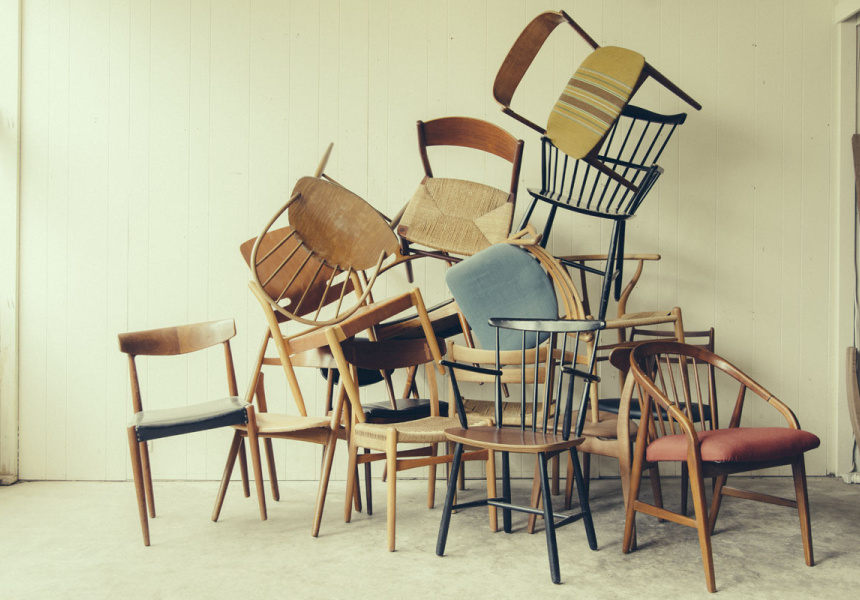It’s been 2000 years since ancient Greek historian Plutarch first put forth the paradox of Theseus’s ship. As the story goes, when the old planks of Theseus’s ship began to decay, they were steadily replaced with new timber until finally no piece of the original ship remained. So the question: is this then still Theseus’s ship?
The philosophical sentiment is echoed in the name that Northcote’s mid-century furniture restorers and dealers, Grandfather’s Axe, have chosen for their store. If both the blade and handle of my grandfather’s axe have been replaced – is it still my grandfather’s axe? Put a different way, if no original members remain in the latest line-up of the Sugababes, are they still the same pop band? And what about a Hans Wegner sofa? How much restoration can be applied to this piece of furniture for it to still be declared a true original?
For Jarrad Turner, co-owner of Grandfather’s Axe, it’s a problem that he has turned often in his mind. He explains that the furniture that is brought to his store will often need to undergo some kind of work, whether it’s a minor fix or a complete restoration. For example, “if it’s a sofa we might have to strip it back to the frame, redo the strapping, replace the foam, replace the upholstery. So it’s almost like a new sofa, really.”
Never miss a Melbourne moment. Make sure you're subscribed to our newsletter today.
SUBSCRIBE NOWHelmed by Turner and his business partner, Ed Klein since 2010, the pair (who actually started out as rivals around the garage sale circuit) now boast one of Australia’s largest selections of European mid-century furniture (mostly Danish modern design, as dictated by customer demand), lighting, ceramics and posters, with a Sydney showroom in addition to its flagship Northcote location.
Following its golden age, the past decade has seen a worldwide resurgence in Danish mid-century modern design; an aesthetic style that worships clean lines, quality workmanship and functionality above all.
You may not think that Scandinavian antiques move very quickly (considering that they’ve been sitting around for at least a half-century already) – but Turner and Klein are now finding themselves hauling in containers from Europe every three to four weeks, packed with original pieces by designers like Hans Olsen, Børge Mogensen, Sigurd Ressell, Hans Wegner and more.
The pieces arrive in an assortment of varying states, ranging from near-pristine to, well, pieces. The items that need work collect in the backroom workshop at the Northcote warehouse, as the staff get to work sanding down legs, gluing collapsed joints, or even rolling up their sleeves for a full reupholstering. Turner explains they try to stay as true as possible to the original designs, referring to their knowledge and photographs in their collections of books.
At the time of our visit, he is working on one of a set of 70 dining chairs recovered from an old Danish Scout hall, rubbing away a faint watermark with a rag dipped in a pungent concoction of turpentine and boiled linseed oil. On one side of the workshop is a neat row of finished, glossy chairs with new black leather seats. On the other side is a motley collection of dusty chairs with no seats– like toothless old men in a dentist’s waiting room.
Despite the vintage nature of the store – the efforts of travelling to Europe, sourcing authentic originals, dealing with a dwindling supply and rising costs (Denmark is only a limited resource), and the labour of restoration means that you won’t exactly come away with an entire living room set for a bargain. With dining chairs starting at just under $200 and rare sideboards reaching $10,000, there are thriftier ways to furnish your home.
So why are people buying vintage at all? There are enough replica stores (much to the continued anguish of antique dealers and designers across the world) offering essentially the same product – an endless supply of shiny, new, identical clones – an ominous vision for vintage traders anywhere.
“There’re more and more of them all the time…it’s a battle that we can’t fight, and certainly can’t win,” Turner concedes.
And although it’s harsh, from a buyer’s point of view – what’s the difference, really? They look the same – give or take a few chips and scuffs. They fulfil the same basic functionality. So why is there such a fierce sense of value placed on something original?
“Sometimes its rarity, its quality. Sometimes it’s just a name,” Turner says candidly. “Even in what we do, we find it quite strange sometimes.”
But there must be some reason that so many buyers choose to bypass the Scandinavian furniture megastores or the gaping, glassy replica showrooms to find this inconspicuous space tucked away on High Street.
“I think the big difference is; you’re buying something from us that will hold its value, even appreciate in value, whereas something that is replica doesn’t have the value of the real thing; it’s worthless almost as soon as you get it home. And it won’t last the time it should, as the designer intended.”
The customers at Grandfather’s Axe, the best of which Turner describes as “coming from the least likely places”, are often bubbling with questions, not just about the practical features of the pieces but the details of their individual histories too.
“A lot of the time we can’t give them much detail, but we can give them a history of who would have had this type of thing, how they would have used it, what houses were like in Denmark at the time.”
It shows that the lure for so many people is not just good design and manufacture, but the irresistible nostalgia that emanates from the pieces themselves. In a throwaway age, there’s something to be said for accepting charge of another person’s loved possession, restoring it – perhaps not with its original pieces, but to its original purpose – simply for the pleasure of it being used and enjoyed once more.
Turner admits that the conundrum of the axe is one that does concern him from time to time. Once something is restored, “Is it an original, or is it remade? Is it almost a replica?”
The alternative route for antiques, of course, is the collector’s path. Some will sit in storage or a museum – worn original leather, springs popping out, gathering dust – as true and authentic as they can be, but never to be used again.
“It’s a strange concept for me when the object is designed to be used and to be loved,” Turner says. “I think generally we put aside the concerns we have for originality when it comes to just making something usable and practical. We’d rather give it a new life. If it was an axe that you couldn’t use because the handle was broken, I think that’s alright to replace it, so then you can go use it to chop wood…I think practicality and function is first.”
Grandfather’s Axe
171 High Street, Northcote
(03) 9489 8648
Hours
Tues to Sun 10am-5pm



